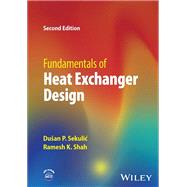Fundamentals of Heat Exchanger Design, Second Edition builds upon the widely-used First Edition, a text often considered to be the most prominent single-volume heat exchanger text on the market. The new and improved Second Edition serves as an equally comprehensive resource, updated to suit the latest technologies and design methods being used in the Heat Exchanger field. Written by First-Edition author Dusan P. Sekulic, this text addresses the latest developments in the industry, including a brand-new chapter on the manufacturing of compact heat exchangers. After opening with a basic introduction to heat exchanger types and design methods, the book goes on to cover more specialized topics such as such as the design of recuperators and regenerators, pressure drop analysis, geometric properties, flow friction, fouling and corrosion, and more. With many significant revisions throughout, this new edition offers more streamlined content while maintaining the consistent, detailed coverage of the fundamentals of the topic that readers appreciated in the First Edition. These unique features position the Second Edition of Fundamentals of Heat Exchanger Design as the ideal text for both engineering professionals and advanced students alike.








